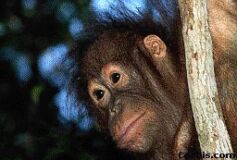
Scientific Name: Pongo pygmaeus | Current Range: Borneo, Sumatra
Two subspecies have been described: the Sumatran Orang-utan, Pongo pygmaeus abelii and the Bornean Orang-utan, Pongo pygmaeus pygmaeus.
Weighing up to 90 kg, the orang-utan is the largest tree-living mammal and the only great ape in Asia. The species is primarily arboreal, and inhabits tropical moist forests, from swamp and lowland (Dipterocarp) forests at sea level to hill and montane fo rests up to 1,800 m. The orang-utan rarely descends to the ground, and moves by climbing and walking through large trees, and swinging from branch to branch with its long arms. The arms can attain a spread of 2.25 m, and reach the ankles when the animal is erect. The orang-utan is mainly frugivorous, the preferred foods are Wild Figs (Ficus spp.) and Durians (Durio spp.), although a wide range of plant and insect foods are also taken. A solitary animal, the orang-utan generally constructs a fresh nest each night although this may be re-used on occasion. Maturity is reached at 7-10 years of age, and the potential lifespan of the species in the wild may be up to 40 years. Observations of orang-utans in the wild suggest that individuals usually occur in very small groups or alone.
The gestation period for the orang-utan is 233-265 days, with a single young or occasio nally twins. Weaning of the young is completed after about 3.5 years. Adult females are the most valuable members of an orang-utan population and the death of an adult female has the greatest influence on increasing extinction rates.

The orang-utan is only found on the islands of Borneo and Sumatra. Orang-utans are known from fossil remains from beyond their present range - in the Padang highlands of central Sumatra, Trinil in Java, Yunnan and Kwangsi Provinces in southern China, and from northern Vietnam. This indicates that the species once ranged much of Southeast Asia.
The Sumatran Orang-utan inhabits the provinces of Aceh and Sumatera Utara in northern Sumatra. The Bornean subspecies is found in all political divisions of Borneo with the possible exception of Brunei-Darussalam. The largest population of this subspecies occurs in Kalimantan, where extensive areas of forest still exist, especially along the east coast. This subspecies is known to inhabit two protected areas in Kalimantan: Tanjung Puting National Park and Kuta i National Park. Status in the latter area is unknown, as vast portions of the forest were damaged by fires in 1986. In Sarawak, the orang-utan's range had been reduced by 1980 to two main population centres: the forests be tween the River Sadong and River Lupar, and the Lanjak-Entimau Wildlife Sanctuary, which was created primarily for orang-utan conservation in 1983. In addition to these two areas, individuals are known to be scattered throu ghout the most remote interior part of the state. In Sabah the subspecies can be found in forested areas throughout the state, although the range is patchy because the orang-utan becomes increasingly scarce at high altitudes. Most orang-utans occur in the lowlands of eastern Sabah. From ground and helicopter surveys carried out in 1985, it is believed to be present in the Danum Valley Conservation Area, Malua -Pin, the Sepilok Forest Reserve, the Tabin Wildlife Reserve and the Kulamba Wildlife Reserve.
The total number of wild orang-utans in Borneo and Sumatra is currently estimated to be less than 30,000 individuals - a figure which represents a decline of 30% to 50% in the last decade. However, there is a need for more precise data based on much-needed surveys.
The threat?

Habitat destruction is by far the greatest threat. This is caused by commercial logging, and agricultural clearance for cash-crops, and subsistence farming. Huge tracts of forest have been cleared throughout the orang-utan's range. Trade is another major threat to the survival of the orang-utan. Although recorded international trade declined in the 1970s, it appears to have increased in the last few years. For example, an estimated 1,000 orang-utans may have reached Taiwan for the pet trade in the last three to four years. In 1991, the capital of Taiwan, Taipei, was thought to have more orang-utans per sq mile than the species' native forests. It is believed that 5-6 orang-utans die for every one that is traded. The animals can fetch US $ 6,000-15,000 when sold as pets. The trade has also been reported in Kalimantan where both live and dead orang-utans are sold. Orang-utan skulls can fetch up to US $70 in towns. A smuggler was recently sentenced in Miami for arranging a shipment in 1990 of six orang-utans (discovered at the Bangkok airport, Thailand) to the former Soviet Union (precise destination unclear).
 Links to other sites on the Web
Links to other sites on the Web
 Orangutan Foundation UK
Orangutan Foundation UK
This page hosted by  Get your own Free Home Page
Get your own Free Home Page



 Links to other sites on the Web
Links to other sites on the Web